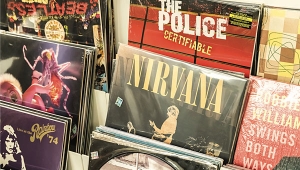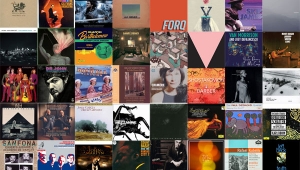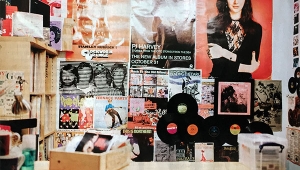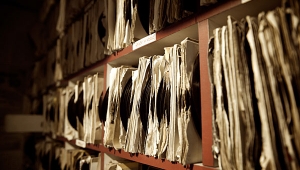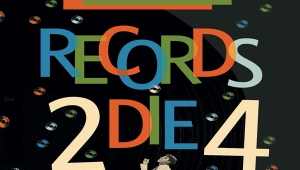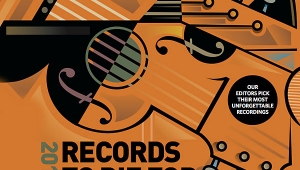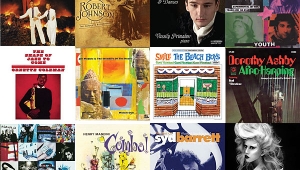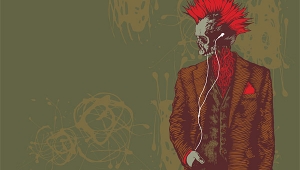| Columns Retired Columns & Blogs |
1996 Records To Die For Page 7
Russ Novak
GIL EVANS: Out of the Cool
Gil Evans, arranger, conductor, piano; The Gil Evans Orchestra
Impulse A-4 (LP, nla), Impulse/MCA MCAD-5653 (CD). Creed Taylor, prod. AAA/ADD. TT: 37:04
LALO SCHIFRIN: New Fantasy
Lalo Schifrin, arranger, conductor, piano; The Lalo Schifrin Orchestra
Verve V6 8601 (LP, nla). Creed Taylor, prod.; Rudy Van Gelder, eng. AAA. TT: 33:43
The Schifrin is out of print, so I don't feel bad about cheating to list two of the greatest big-band jazz albums. These guys know how to modulate the dynamics of a big band and avoid the trap of boring, non-stop wailing. Both rhythm sections are incredible, building tension released only through the poignancy of the soloists; listen to "La Nevada" (Evans) and "The Peanut Vendor" (Schifrin). Sound is multimiked but natural; both will tax your system to reproduce full dynamic bloom and pulse, not simply loudness.
MICHEL LEGRAND: Legrand Jazz
Michel Legrand, arranger, conductor; mixed ensembles including: Miles Davis, trumpet; John Coltrane, Ben Webster, tenor sax; Art Farmer, Donald Byrd, trumpet; Bill Evans, piano.
Classic Records/Columbia CS 8079 (LP), Philips 830 074-2 (CD). AAA/AAD. TT: 44:47
Bright, easily swinging jazz whose complexity and musical value belie the breezy feel. French master arranger Michel Legrand (Umbrellas of Cherbourg, The Thomas Crown Affair) used three small big-band ensembles on separate 1958 recording dates to keep the sound and feeling unique and stimulating from track to track. The quality of the arrangements transcends the period. Sound is natural and transparent, and finally back in print on vinyl; the CD ain't bad either!
Thomas J. Norton
TURTLE CREEK CHORALE: Postcards
Timothy Seelig, Turtle Creek Chorale
Reference Recordings RR-61 (LP), RR-61CD (HDCD CD). J. Tamblyn Henderson, Jr., prod.; Keith O. Johnson, eng.; Michael "Pflash" Pflaumer, HDCD eng. AAA/DDD. TT: 60:00
Reference Recordings has made a number of recordings of the Turtle Creek Chorale, all of them worth recommending, but none is more accessible than this collection of short works from around the world, some familiar, others delightfully new. The performances are excellent across the board, though many may perhaps excel in my mind simply because the pieces are so new to me that I have no basis for comparison. They will have to be definitive until someone else challenges them.
BALTIMORE CONSORT: Bright Star Day
Custer LaRue, soprano
Dorian DOR-90198 (CD only). Douglas Brown, prod.; Craig D. Dory, Douglas Brown, David H. Walters, Brian C. Peters, engs. DDD. TT: 67:19
It's a bit late for a Christmas recording, but R2D4 comes at the wrong time of year. That's no reason to overlook a great compilation such as this mixture of instrumental and vocal works from the British Isles, Germany, and Appalachia. (This is the second Baltimore Consort recording on Dorian I've recommended. The other, every bit as good, is On the Banks of the Helicon.)
Peter W. Mitchell
SCHUMANN: Symphonies 2 & 3
David Zinman, Baltimore Symphony
Telarc CD-80182 (CD only). James Mallinson, prod.; Jack Renner, eng. DDD. TT: 69:50
Schumann's symphonies are infamous for their thick, turgid orchestrations. Solos are rare, usually doubled by other instruments and backed up by strings. Though recent recordings of Schumann have tried to offset that with a sparse Mozartean orchestra, Telarc's orchestral recordings have tended toward an overripe bass balance, the opposite of what's needed to clarify Schumann's thick textures.
JAN GARBAREK/HILLIARD ENSEMBLE: Officium
Jan Garbarek, saxophones; Hilliard Ensemble, voices
ECM New Series 1525 (78118-21525-2, CD only). Manfred Eicher, prod.; Peter Laenger, tonmeister. DDD. TT: 77:41
These 15 Gregorian plainchants and Renaissance motets are performed "straight" by the Hilliard Ensemble (four male voices), though the spacious acoustic of the large church often makes it seem as if several more voices were singing. They're accompanied by Garbarek's saxophone---sometimes in an appropriate monotone, often providing an independent counter-melody. His contribution is basically jazz-like, though not in the sense of producing bebop rhythms and "blue" notes; Garbarek makes up his own melodic line as he goes along. On a couple of occasions he guesses wrong, producing a melody that sounds inappropriately modern. But most of the time he fits right in with the essentially spritual nature of the music. If you haven't heard it, you're in for a surprise. (XVII-10)
GIL EVANS: Out of the Cool
Gil Evans, arranger, conductor, piano; The Gil Evans Orchestra
Impulse A-4 (LP, nla), Impulse/MCA MCAD-5653 (CD). Creed Taylor, prod. AAA/ADD. TT: 37:04
LALO SCHIFRIN: New Fantasy
Lalo Schifrin, arranger, conductor, piano; The Lalo Schifrin Orchestra
Verve V6 8601 (LP, nla). Creed Taylor, prod.; Rudy Van Gelder, eng. AAA. TT: 33:43
The Schifrin is out of print, so I don't feel bad about cheating to list two of the greatest big-band jazz albums. These guys know how to modulate the dynamics of a big band and avoid the trap of boring, non-stop wailing. Both rhythm sections are incredible, building tension released only through the poignancy of the soloists; listen to "La Nevada" (Evans) and "The Peanut Vendor" (Schifrin). Sound is multimiked but natural; both will tax your system to reproduce full dynamic bloom and pulse, not simply loudness.
I challenge audiophile reissue labels to do state-of-the-art remasterings of these. The massed brass and percussion on "Peanut Vendor" should give an ulcer to the engineer attempting to capture it clearly.
MICHEL LEGRAND: Legrand Jazz
Michel Legrand, arranger, conductor; mixed ensembles including: Miles Davis, trumpet; John Coltrane, Ben Webster, tenor sax; Art Farmer, Donald Byrd, trumpet; Bill Evans, piano.
Classic Records/Columbia CS 8079 (LP), Philips 830 074-2 (CD). AAA/AAD. TT: 44:47
Bright, easily swinging jazz whose complexity and musical value belie the breezy feel. French master arranger Michel Legrand (Umbrellas of Cherbourg, The Thomas Crown Affair) used three small big-band ensembles on separate 1958 recording dates to keep the sound and feeling unique and stimulating from track to track. The quality of the arrangements transcends the period. Sound is natural and transparent, and finally back in print on vinyl; the CD ain't bad either!
Thomas J. Norton
TURTLE CREEK CHORALE: Postcards
Timothy Seelig, Turtle Creek Chorale
Reference Recordings RR-61 (LP), RR-61CD (HDCD CD). J. Tamblyn Henderson, Jr., prod.; Keith O. Johnson, eng.; Michael "Pflash" Pflaumer, HDCD eng. AAA/DDD. TT: 60:00
Reference Recordings has made a number of recordings of the Turtle Creek Chorale, all of them worth recommending, but none is more accessible than this collection of short works from around the world, some familiar, others delightfully new. The performances are excellent across the board, though many may perhaps excel in my mind simply because the pieces are so new to me that I have no basis for comparison. They will have to be definitive until someone else challenges them.
Striking sound quality is no surprise from Reference Recordings. The CD is HDCD-encoded, but I consider it reference quality even without HDCD decoding. Smooth, sweet, and natural-sounding, with a dramatic sense of depth and space, it's a first-class effort all around. (XVIII-6)
BALTIMORE CONSORT: Bright Star Day
Custer LaRue, soprano
Dorian DOR-90198 (CD only). Douglas Brown, prod.; Craig D. Dory, Douglas Brown, David H. Walters, Brian C. Peters, engs. DDD. TT: 67:19
It's a bit late for a Christmas recording, but R2D4 comes at the wrong time of year. That's no reason to overlook a great compilation such as this mixture of instrumental and vocal works from the British Isles, Germany, and Appalachia. (This is the second Baltimore Consort recording on Dorian I've recommended. The other, every bit as good, is On the Banks of the Helicon.)
The performances are perfect, and Dorian's sound---recorded in the superb acoustics of the Troy Savings Bank Music Hall---could hardly be bettered. Many of these Christmas songs will be new to you, so buy it now and play it next Christmas. Better yet, buy it now and play it all year long. (XVIII-3)
Peter W. Mitchell
SCHUMANN: Symphonies 2 & 3
David Zinman, Baltimore Symphony
Telarc CD-80182 (CD only). James Mallinson, prod.; Jack Renner, eng. DDD. TT: 69:50
Schumann's symphonies are infamous for their thick, turgid orchestrations. Solos are rare, usually doubled by other instruments and backed up by strings. Though recent recordings of Schumann have tried to offset that with a sparse Mozartean orchestra, Telarc's orchestral recordings have tended toward an overripe bass balance, the opposite of what's needed to clarify Schumann's thick textures.
This disc came as a delightful surprise: Telarc has caught the magic of Baltimore's new Meyerhoff Hall with sound that is appropriately large-scaled and weighty, yet remarkably clear and well-focused. The orchestra spans the full soundstage from speaker to speaker, but the imaging of the woodwinds in the center is not at all vague. Best of all, Zinman seems to shape the music with springs in his shoes: individual phrases constantly acquire lively momentum through slight accelerandi, rubati, and ritards, while sforzandi give phrases an amazing variety of expression. Bottom line: satisfying, lively performances in gorgeous orchestral sound---including brass chorales that bring tears to my eyes.
JAN GARBAREK/HILLIARD ENSEMBLE: Officium
Jan Garbarek, saxophones; Hilliard Ensemble, voices
ECM New Series 1525 (78118-21525-2, CD only). Manfred Eicher, prod.; Peter Laenger, tonmeister. DDD. TT: 77:41
These 15 Gregorian plainchants and Renaissance motets are performed "straight" by the Hilliard Ensemble (four male voices), though the spacious acoustic of the large church often makes it seem as if several more voices were singing. They're accompanied by Garbarek's saxophone---sometimes in an appropriate monotone, often providing an independent counter-melody. His contribution is basically jazz-like, though not in the sense of producing bebop rhythms and "blue" notes; Garbarek makes up his own melodic line as he goes along. On a couple of occasions he guesses wrong, producing a melody that sounds inappropriately modern. But most of the time he fits right in with the essentially spritual nature of the music. If you haven't heard it, you're in for a surprise. (XVII-10)
- Log in or register to post comments



